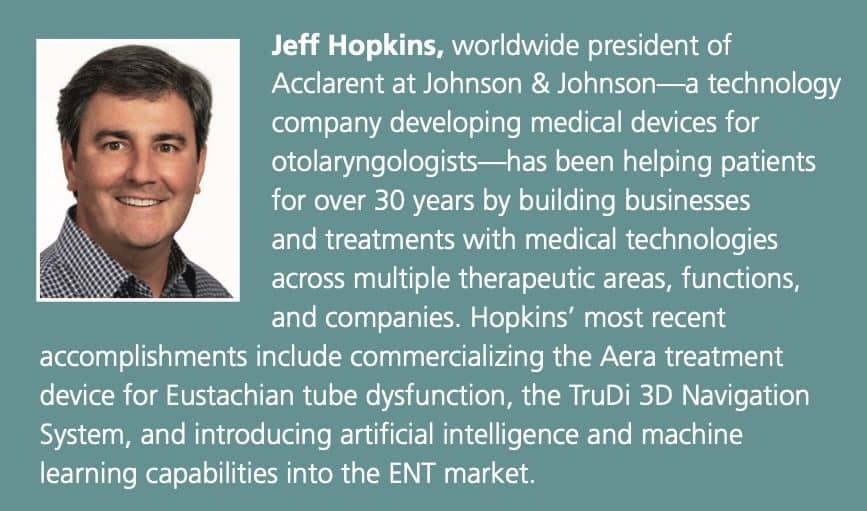Opportunities for the industry to help transform patient outcomes abound—just look at the middle ear.
Hearing Aid | April 2023 Hearing Review
By Jeff Hopkins
Sinus pressure and pain, hearing loss, chronic ear infections and pain, and ringing in the ear are the most common reasons for visits to an otolaryngologist, also known as an ENT.1 Recently, I became an ENT patient myself when breathing through my nose became difficult. My ENT diagnosed me with nasal obstruction and chronic sinusitis and successfully treated my condition with a nasal obstruction balloon dilation and balloon sinuplasty quick, minimally invasive outpatient procedures. To my great relief, I am now breathing easier; but this isn’t always the case for ENT patients.

Ear and sinus infections are some of the top reasons for visits to general practitioners in the US.1 And often, those patients are prescribed antibiotics that treat symptoms rather than the root cause of infections. The fact is minimally invasive procedures can be very successful in resolving ENT problems, yet too few patients receive the treatment they need. And unfortunately, the same can be said for those patients who require a more invasive approach. While more than 30 million Americans are diagnosed with chronic sinusitis, only approximately 800,000 receive surgical treatment.2 The rising cost of healthcare and increase in revision rates often push people away from treatment. For example, a large cohort study showed that the long-term chronic sinusitis revision rate for endoscopic sinus surgery exceeded 15%.3
Given today’s advances in science and technology, I believe that the MedTech industry has the unprecedented opportunity to champion transformational innovation that could drive better outcomes for all people struggling with ENT issues. By working together, the medical and scientific community including industry, academia, and physicians can transform the landscape of ENT treatment and make a difference for patients.
There are three primary areas of opportunity for our industry to change the trajectory of ENT treatment:
• Invest in transformational innovation
• Harness data and evidence
• Help physicians deliver consistent, successful patient outcomes
To begin with, let’s invest in transformational vs incremental innovation to advance science and technology. This means understanding where the unmet needs are from the perspective of patients, physicians, and the healthcare system. And then understanding where science and technology are headed and harnessing the best ideas to translate them into tangible solutions. At Acclarent, we are listening to physicians and responding to unmet needs, taking a nimble approach, and thinking outside the box. By harnessing existing know-how and applying lessons learned in other therapeutic areas, we were able to create the first AI-powered ENT navigation system helping to shape a future where ENT surgical intervention is less invasive, more precise, and personalized. We also introduced the first FDA-cleared nasal obstruction balloon dilation system, which allows physicians to efficiently address a deviated septum and enlarged turbinates across all sites of care, whether in the operating room or an in-office setting.
The key to our ability to demonstrate the value of our innovation is evidence generation and dissemination. Today, more than ever, we have sophisticated tools like Big Data and computer analytics that can help gather and glean insights from real-world evidence and identify opportunities to make the greatest impact. At Acclarent, we are investing in data and evidence so that the criteria for the appropriate use of our products are clear and based on facts. To illustrate this, we can look at the treatment innovations we are making around the middle ear.
At Acclarent, we invested in a robust clinical trial to bring forward the first device in the US specifically designed to dilate the Eustachian tube for adult patients with persistent Eustachian tube dysfunction.4 The clinical trial provided evidence needed to gain novel Category I Current Procedural Terminology (CPT) codes and reimbursement in one of the biggest unmet need areas in ENT. Continuing to advance nonsurgical, minimally invasive procedures is the future of treating conditions of the middle ear, and possibly replacing or improving on older technologies, such as ear tubes.
Now, if we are to change the trajectory of ENT treatment, we must also look at surgical innovations. In ENT surgery, as in other areas, success is highly dependent on the skill of the surgeon. Technology can be the great equalizer, helping level the playing field to ensure physicians are set up for success to deliver care in a consistent manner—whether they are at a large institution or in private practice. Easier-to-use, smarter tools, such as those with AI and navigation, hold a lot of promise to help achieve greater consistency and higher success rates. Today, advanced tools are becoming more accessible for large institutions and private practices alike, allowing physicians to treat more patients with the high-quality care they deserve.
I believe that ENT care is at a tipping point. We now have the technology to shift from open procedures to minimally invasive ones, and from generic approaches to personalized solutions. We in the MedTech industry have an opportunity to fuel a cycle of growth and invest in innovation that drives better outcomes, which will in turn provide the fuel to drive even more investment and innovation on behalf of our customers and the patients they serve. By harnessing the power of science and technology, we can drive better safety, effectiveness, and efficiency in ENT procedures, deliver better outcomes, and make a difference for patients, physicians, and the healthcare system.
The ENT space, on the provider side, is rife with opportunity. But more importantly, people are in need. Millions of underserved patients live in chronic discomfort. I am grateful to my ENT physician and to the technology that made it possible to solve my chronic ENT condition. I believe that everyone deserves that same outcome.
Citation for this article: Hopkins J. Overcoming the ENT innovation lag. The Hearing Review. 2023;30(4):26-27.
References:
1. Centers for Disease Control and Prevention. Chronic Sinusitis. Available at: https://www.cdc.gov/nchs/fastats/sinuses.htm.
2. Hepworth E, Meyers A, Kadkade P, et al. Balloon Sinusplasty. Available at: https://emedicine.medscape. com/article/1574031-overview. Updated December 2020.






